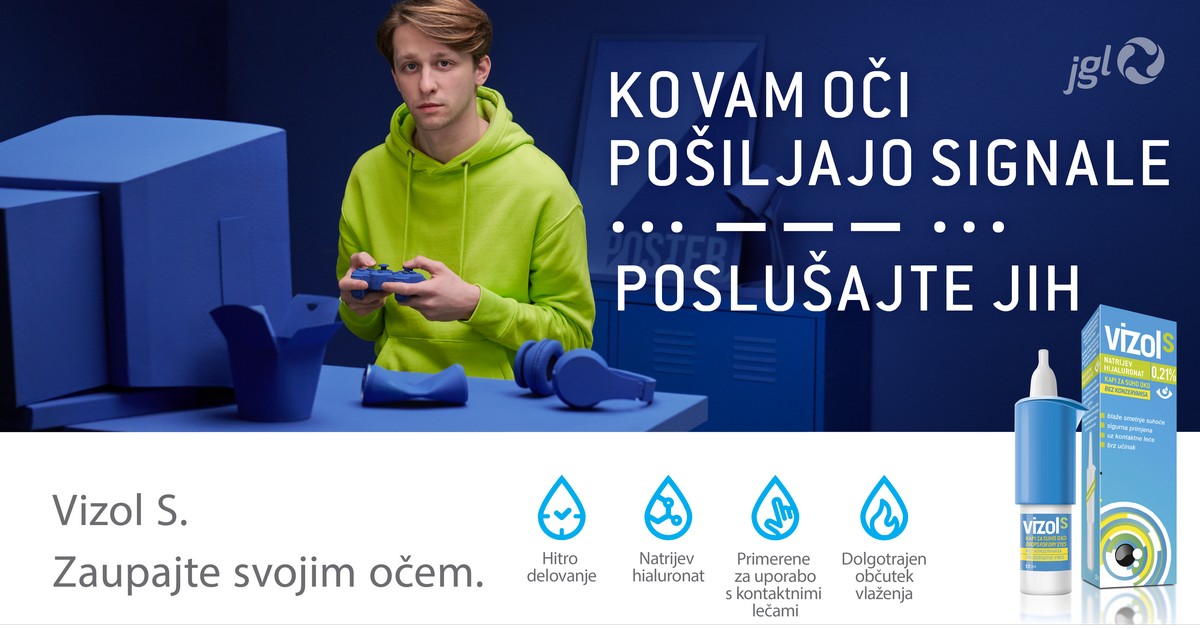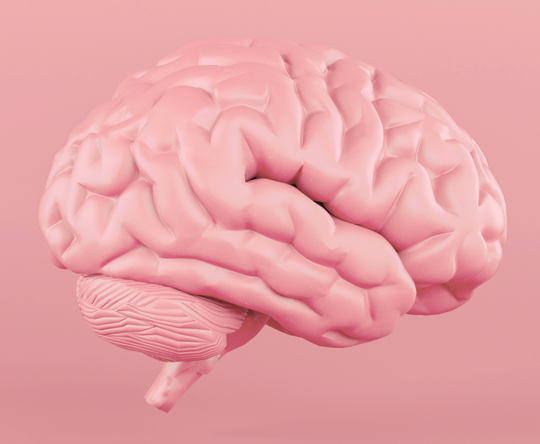The disease is usually asymptomatic and people are unaware that they have it until it’s progressed. That is why glaucoma is also called the "insidious thief of sight".
The results of the latest research suggest that a balanced diet can protect our eyes and prevent the onset of glaucoma. Some nutrients such as vitamins A, B2 and B3 and omega-3 fatty acids can have a protective effect. They can be found in fresh carrots, kale, walnuts, peaches and oily fish (e.g., sardines). The risk of developing glaucoma can be further reduced with regular aerobic exercise (walking, cycling, aerobics) which keeps eye pressure under control, the renowned ophthalmologist Professor Barbara Cvenkel, MD, explains for X-Lab by JGL.
According to the estimates by the World Health Organization, there are a total of 2.2 billion people in the world who have an eye disease, and for at least a billion of them the disease could have been prevented. Apart from aging and genetic predispositions, eye health is influenced by many other factors we have control over ourselves, which enables us to prevent disease and improve our health. This is why leading ophthalmologists, neurologists, endocrinologists, psychiatrists, rheumatologists, otorhinolaryngologists, plastic surgeons, general practitioners, pharmacists and engineers are brought together at X-Lab — the expert research hub by JGL — to analyse the latest research and, by applying a holistic approach, to share with us how to take care of our eye health and why that is important for our whole bodies.
1 With glaucoma, patients most often notice symptoms and visual disturbances at a stage when optic nerve damage has already occurred. How can we react as soon as possible?
By definition, glaucoma is progressive damage to the optic nerve or, in other words, progressive optic neuropathy. The disease is usually asymptomatic and people are unaware that they have it until it’s progressed. Visual acuity can be maintained for a long time during the disease, and the disease can be asymmetric — meaning, for example, it can be advanced in one eye and in the initial stage in the other one — making it easy to miss any changes when looking with both eyes. Patients with glaucoma usually don’t see black spots in the visual field, but rather have so-called negative scotomas — visual field defects that the patient is not aware of and that are detected only during an examination. With advanced glaucoma, patients often state that their vision is blurrier, notice that a part of the picture is missing, or that a part of the picture is more blurred. That is why glaucoma is also called the “insidious thief of sight”. It is similar to diabetes in that half of the people with glaucoma do not know they have it.
2 Is glaucoma hereditary in the majority of cases?
People with glaucoma present in the family medical history (first degree relatives — parents, siblings) are nine times more likely to develop glaucoma than people without glaucoma in their family medical history. The most common form of glaucoma in Europe is primary open-angle glaucoma, where not one gene is changed but several. This means that there exist many gene variants that are also present in the healthy population. Each variant has little effect on disease development, but in combination with risk factors for glaucoma development (e.g., high intraocular pressure) it can contribute to the development of glaucoma. This is why genetic testing to predict the risk of glaucoma or its course is unproductive.
However, in some cases genetic testing can be helpful, for example for the younger member of a family whose members have severe, early-onset glaucoma. In such rare cases — these cover just 4–6% of all forms of primary open-angle glaucoma — genetic testing of family members is necessary to identify the mutation in the myocilin gene responsible for familial glaucoma. If testing shows that the younger family member doesn’t have this mutation, then their risk of developing glaucoma is the same as in other people in the population and does not require strict monitoring. However, if the mutation is detected, regular check-ups and early treatment of the initial stage of glaucoma are necessary
3 What is the key to effective glaucoma treatment?
The only treatment proven to be effective is the lowering of intraocular pressure, which slows down the onset and progression of glaucoma. Intraocular pressure can be lowered to a level safe for the patient’s eye, the so-called targeted intraocular pressure, with eye drops, laser, or surgery, and it is expected that this will slow down the progression of glaucoma and maintain good eyesight through life. The highest risk factor for glaucoma blindness is detecting the disease (too) late, when most of the optic nerve fibres have died.
With newly diagnosed glaucoma, treatment usually begins with eye drops, which lower the intraocular pressure by reducing the formation of aqueous humour in the eye and / or increasing its outflow from the eye. Most patients need lifelong treatment, so their involvement in the treatment process is very important. In general, the involvement of patients in the treatment process is lower with chronic asymptomatic diseases than with acute ones (for example, pneumonia). Improper use of eye drops, skipping use, and discontinuing treatment were reported in more than half of glaucoma patients, and in those with newly diagnosed glaucoma, only a quarter of patients continued their treatment in the first two years. If the patient does not take eye drops regularly, the intraocular pressure oscillates more, causing more damage to the optic nerve. This was confirmed by a seven- year study that found that the higher the percentage of skipped eye drop doses, the faster the glaucoma progression.
4 Which groups are most at risk of developing glaucoma: women over 40 ...?
The most important risk factors for the development of primary open-angle glaucoma — the most common form of glaucoma in Slovenia — are: high intraocular pressure, age over 65 years, smaller central corneal thickness, glaucoma in the family medical history, high myopia, African ethnicity, and heart disease.
Another important group is the group with primary angle-closure glaucoma, where high intraocular pressure occurs due to the impaired outflow of aqueous humour from the eye. In Europe, this form of glaucoma is ten times less common than primary open-angle glaucoma. Risk factors for primary angle-closure glaucoma include: age around 60, female sex, ethnicity (Asian and Inuit), family medical history, high farsightedness (hyperopia), and a smaller eye shape.
5 Is it possible to detect glaucoma before the onset of visual impairment and prevent it? How can we do that?
It is possible to diagnose glaucoma before vision loss. If the disease is detected early enough, the optimal lowering of intraocular pressure and patient monitoring can significantly slow down or even prevent the worsening of glaucoma and help maintain good visual function. Glaucoma is diagnosed with an eye examination which includes measuring the intraocular pressure, examining the eyes with a slit lamp, and examining the posterior side of the retina. The changes characteristic of the early stage of glaucoma are often manifested in the posterior side of the retina (the background of the eye) — at the exit of the optic nerve from the eye, before the first scotoma or visual disturbances in the vision field appear. At that point, the patients still experience no problems. Lowering intraocular pressure down to a safe level and monitoring the patient can prevent the progression of glaucoma
6 What are your best recommendations for optimal eye health?
Because the prevalence of glaucoma is low (average prevalence is 2–3% between the ages of 40 and 80), implementing a screening program makes no sense. Elevated intraocular pressure (above 21 mmHg) is not a diagnostic criterion, but only a risk factor for the development of glaucoma. In 2/3 of patients with newly diagnosed glaucoma, intraocular pressure was statistically normal at the first examination. It is therefore important that people with glaucoma in the immediate family visit an ophthalmologist before the age of 35. Others need a thorough eye examination when prescribing their first reading glasses (around age 40) and at least every time they change their dioptres. In addition to determining both distance and near visual acuity, eye examination includes measuring the intraocular pressure, examining the eyes with a slit lamp, and examining the posterior side of the retina. In case the papilla behind the glaucoma looks suspicious, an examination of the vision field is required.
The results of the latest research suggest that a balanced diet can protect our eyes and prevent the onset of glaucoma. Some nutrients such as vitamins A, B2 and B3 and omega-3 fatty acids can have a protective effect. They can be found in fresh carrots, kale, walnuts, peaches and oily fish (e.g., sardines). The risk of developing glaucoma can be further reduced with regular aerobic exercise (walking, cycling, aerobics) which keeps eye pressure under control.
(This content is the result of independent clinical experience and the professional work of the author and does not necessarily reflect the opinion and attitude of the client.)
QUIZ
SUFFERING FROM DRY EYE SYNDROME? ANSWER THESE QUESTIONS AND FIND OUT HOW TO PREVENT IT AND WHAT TO DO WHEN YOU ARE ALREADY FEELING THE SYMPTOMS
QUIZ





